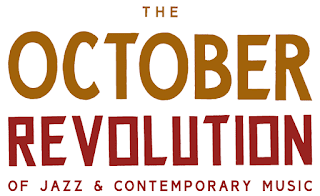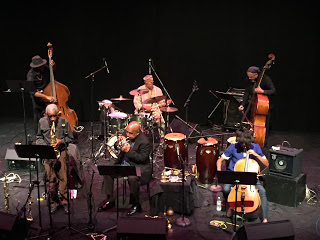By Paul Acquaro
Saturday afternoon, Race St Pier and Fringe Arts
 |
| A member of Orchestra 2001 performing John Luther Adams’ Across the Distance |
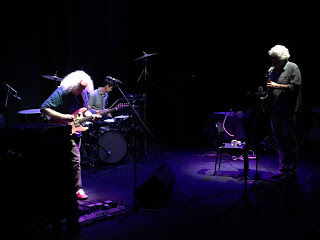 |
| Son of Goldfinger: David Torn, Ches Smith, Tim Berne |
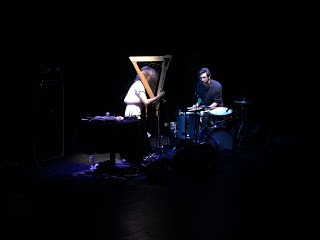 |
| Zena Parkins and Brian Chase Duo |
Harpist/sound manipulator Parkins’ harp is much more than a harp – in fact, I wonder if harp is even the right word for it. It’s a controller, hooked up to a wild assortment of electronics and finally into an amplifier. As she and drummer Brian Chase kicked off their set, it sounded like she was playing bass. Also to note, she was playing the frame of the instrument, not the harp strings themselves. Chase, with mallets in hand and at a conventional kit, kept it simple, that is until he began to disassemble pieces of his high-hat to get some other percussive sounds. The duo was intense, Parkins provided a mix of tone and attack as she looped her sounds into an impressive stack. Chase’s playing was responsive and provided a strong pulse, if not time. There is a bit of theater attached as well in Parkin’s lunging and rhythmic swoons at the harp, and here working both the physical and the musical, they reached an apex. They continued through several other improvisations and the range of sounds Parkin’s can create is mindboggling: digging into rhythmic strums, pulling out stinging single notes, and scratching out synthesized tones. The two work quite well together and their mid-afternoon set was a highlight.
 |
| Tim Berne’s Snakeoil |
Snakeoil has been Berne’s main vehicle for his compositions over the past several years. A spate of albums on ECM have ranged from excellent to even more excellent, the most recent Incidentals is a masterful album, the second featuring the group augmented by guitarist Ryan Ferrier, who was not playing with the group today. The line-up in addition to Berne: reeds player Oscar Noriega, pianist Matt Mitchell, and drummer Ches Smith. Smith again kicked things off, this time with a bunch of small percussion, while Noriega readied his Bb clarinet and proceeded to play a gentle melody along with Mitchell. Only after a good stretch, Berne came in, while Smith provided some contrast on the vibraphone. Noriega switched to bass clarinet and he worked a melody together with Mitchell, the group pulled together in all their complexity. One complaint is that Mitchell’s acoustic piano could not cut through the group ‘s sound strongly and some of the bass’ function was lost, causing the music to float a little more than usual. However, the upshot was that Smith’s unusual work on the timpani and vibraphone gained some extra prominence. To my ears, the strength of Berne’s compositions is how he sets up his musical contraptions, whose components always come together to create beautifully challenging musical jigsaw puzzles.
Saturday Night, Fringe Arts
The group came out on stage and faced east. Mitchell played a single note, they took their playing positions, and Paul launched into an extensive bass solo. He was then joined by Shahid and Moye for a brief interlude, and then the second bassist took over. Ragin took a quick turn on the piccolo trumpet as Mitchell readied his soprano sax. As the focus shifted to Mitchell, he let loose a torrent of squeals and squeaks in the extended range of the instrument. Coupled with circular breathing, the effect was both jarring and soothing in some manner. He kept this theme going after cueing in the group, adding more notes from the lower register. Ragin took over next, for an extensive solo, and then it was Reid’s turn. She really stood out as she spun a engrossing fast paced passage full of double and triple stops. In fact in a few conversations with concert-goers afterwards they basically said they were utterly smitten with her playing. The quality of the music only increased over the course of the set. Towards the end, Moye’s received some spotlight, and the drummer who had moved between hand percussion and kit over the course of the set, led the group energetically into their closing theme. The group came back for a short encore and the audience was left on a wonderfully disoriented high – the hour set seemed to have passed in mere minutes.
 |
| Mike Lorenz Trio |
Sunday Afternoon, Fringe Arts
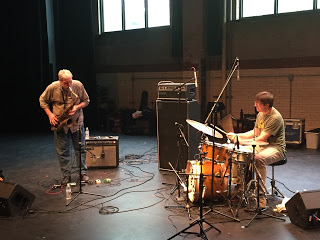 |
| Jim Sauter and Kid Millions |
Sauter is one of the saxophonists from the heavy noise/jazz group Borbetomagnus and Millions (Jim Colpitts) the drummer of rock band Oneida. The two together were a force of nature – and it was loud – from the opening blat of Sauter’s sax, nothing but energy poured forth from the duo. The extreme feedback from Sauter’s towering amplifier, to the string of pedals he ran his instrument through guaranteed hearing damage for those without ear plugs, but between the textures of his sounds and the structure in Million’s patterns, an interesting – though not for the faint of heart – music emerged. It was certainly a jolt of energy in the early afternoon.
Sunday Afternoon, Old City
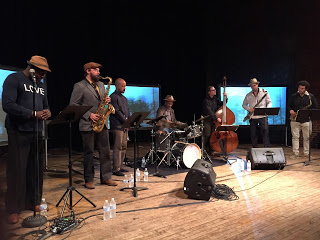 |
| Mike Reed’s Flesh and Bone |
 |
| Cortex: Gard Nilssen, Ola Høyer, Kristoffer Berre Alberts, Thomas Johansson |
This quartet of bad ass Norwegians have released several albums on Clean Feed, one of the more recent ones was from a concert at iBeam in Brooklyn from a few years back, and it caught the band’s energy well, but nothing compares to seeing them in a several hundred year old church with its aged acoustics and connotations of freedom and revolution. Trumpeter Thomas Johansson, saxophonist Kristoffer Berre Alberts, bassist Ola Høyer, and drummer Gard Nilssen did not let the concert goers down, their precise playing and concise melodic heads gave way to fierce improvisations, showcasing some rare talent – Alberts playing seems to embody the spirit of Brotzmann coupled with jaw-dropping technical proficiency. While Alberts and Johansson are powerhouse improvisers a lot of credit should go the writing – crystalline and punchy, it features the exciting interplay and somehow has a synergistic effect where the two horns can fill a room – a church even – with sound. Nilssen and Hoyer root the group. They are dependable and never let a beat slip, providing a solid underlayment that no doubt lets the two horn players do what they do best.
 |
| Burton Greene (press photo) |

